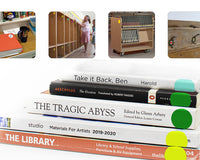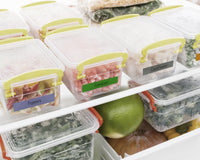
A stockroom may be the most important part of a retail store. As such, it’s crucial that this room has an effective design so the resources stored there are easy to find. The typical retail store’s stockroom is huge and full of products. And when there is no sorting process in place, it’s incredibly difficult to find things. If you are looking to improve your retail store’s stockroom, use our guide.
Consider Moving Shelves
Many stockrooms have limited space. If this is the case for your shop, an excellent way to maximize your space is to use moving shelves. Moving shelves eliminate aisles thanks to the traction system. The shelves are on wheels, and users can easily move them by rotating spin handles. They’re also safe, as you can lock the different sections in place when navigating the shelves. Moving shelves will give your retail store’s stockroom more space for other tasks. A conveyor belt for clothes is another effective option to keep operations running smoothly.
Color Coordinate
Another essential part of improving a retail store’s stockroom is to color coordinate throughout. You can color coordinate many things—from the boxes on the shelves to the shelves themselves. It can be extremely difficult to locate items you need when everything looks the same. Color coordinating can make the searching process far more efficient. We recommend adding color-coding stickers to the items.
Create a System
In addition to color coordinating, you should create a sorting system. This process should be easy to follow, as it is imperative all employees are on the same page. Typically, people will divide the shelves into sections and give every box a label to make it clear there is a specific order in place. An organized and tidy stockroom will reduce the risk of losing something and ensure employees properly put things back.
Use Clear Labels
An essential part of making a stockroom system work is to make the shelves and boxes easily identifiable. Labels are a great way for everyone to quickly find and organize items. You need to make sure the labels are easy to understand and read—illegible labels can lead to problems down the line. You can even use color labels. With these, you can also implement the color-coding technique. It’s one more way to clarify the stockroom’s set up.
Utilize High Ceilings
Although most retail store stockrooms use shelves to a great degree, many fail to utilize ceilings space. If you have high ceilings, you can vertically build upward instead of horizontally. Depending on how big your stockroom is, you may require machines to retrieve items. However, in some cases, you may only need a step stool. The important thing is to make sure everyone can safely fetch something off the highest shelf in the room.
Repair Damaged Boxes
Damaged boxes are a common fault in stockrooms. This can go on to cause a disorganized mess in the back, potentially leaving items all over the place and out of order. To prevent this, either repair damaged boxes with tape or invest in durable ones you can reuse. Tough plastic bins with lids will no doubt last far longer than a cardboard box. A bin with a lid may be easier to transport off the shelf, and you can continue to stack items even after opening them.
Give Employees A Personal Space
A stockroom will need an area dedicated to employees as well. This section should be like a break room and include storage where employees can place their personal items. If space is extremely limited, you’ll still want to provide employees with a safe place to keep their things. This may involve installing a few lockers and coat hangers. You may also want to consider making the area more comfortable. Provide comfortable seating and some counter space, so employees can relax during their breaks.
Monitor the Temperature
To improve productivity and retain the quality of the products, be sure to monitor the temperature. An uncomfortable temperature, such as the stockroom getting too humid, can lead to damaged boxes and low productivity. Therefore, you’ll want to make sure the stockroom is at an appropriate temperature. As such, you should regularly check your air conditioning and heating unit to ensure it’s in working order.
Get Rid of Unnecessary Items
A huge detractor that can cause disorganized chaos is having unnecessary items scattered all over the place. Try to avoid having any unnecessary items in your stockroom. When people don’t dispose of or put back items in their rightful spot, it can slowly start to add up. Before you know it, you’re once organized stockroom is overflowing with clutter. To avoid this, make sure everyone is aware of the organization systems in place, and make it a rule to not leave things out.
Ensure Safety
Safety should be a huge priority within every retail store’s showroom walls. This means having the proper alarm systems in place and keeping the shop clear of unnecessary possessions. You want employees to be able to safely move around the space. You should also provide personnel with safety protocols and clear exit signs—especially in the stockroom.
Provide Important Information
One final way you can improve a stockroom is to have a clear space on the wall for information. Communication is key to an efficient workplace, so include all pertinent items—from guidelines to the employee schedule. Choose an area of the stockroom and let employees know it’s where they can find important information regarding numerous things. Many store owners also add a whiteboard. This way you can write down the schedule for the day or mention upcoming events. Consider placing this within or near the employees’ break area.
Retail stores have a lot of inventory, so the last thing anyone wants is items strewn around, making it difficult to find anything. A disorganized stockroom can hurt your business down the line. To prevent this from occurring, create a strategy and utilize these tips. It’s a great way to prepare for the constant coming and going of packages and items. All the steps we mention work hand in hand to create the ultimate storage space.








1 comment
Eve Mitchell
It’s good to know that moving shelves have spin handles for easy movement. I own a warehouse for my business, and I’ve noticed that it’s not super organized. We’re doing a big restock this week, so after that, I’ll look online for better shelving options. https://www.pippmobile.com/markets-served/retail/